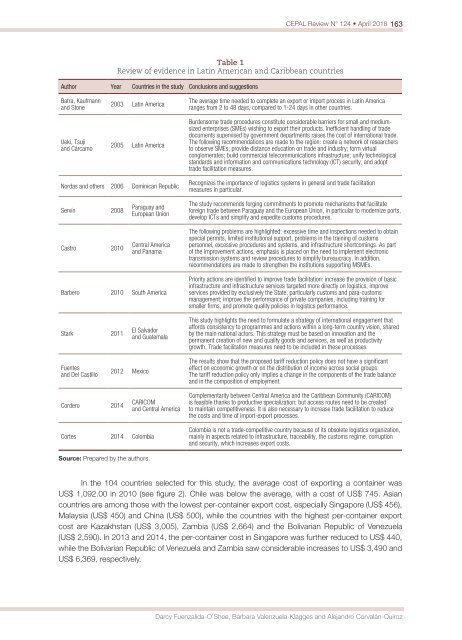CEPAL Review no. 124
April 2018
April 2018
Create successful ePaper yourself
Turn your PDF publications into a flip-book with our unique Google optimized e-Paper software.
<strong>CEPAL</strong> <strong>Review</strong> N° <strong>124</strong> • April 2018 163<br />
Table 1<br />
<strong>Review</strong> of evidence in Latin American and Caribbean countries<br />
Author Year Countries in the study Conclusions and suggestions<br />
Batra, Kaufmann<br />
and Stone<br />
Ueki, Tsuji<br />
and Cárcamo<br />
2003 Latin America<br />
2005 Latin America<br />
The average time needed to complete an export or import process in Latin America<br />
ranges from 2 to 48 days, compared to 1-24 days in other countries.<br />
Burdensome trade procedures constitute considerable barriers for small and mediumsized<br />
enterprises (SMEs) wishing to export their products. Inefficient handling of trade<br />
documents supervised by government departments raises the cost of international trade.<br />
The following recommendations are made to the region: create a network of researchers<br />
to observe SMEs; provide distance education on trade and industry; form virtual<br />
conglomerates; build commercial telecommunications infrastructure; unify tech<strong>no</strong>logical<br />
standards and information and communications tech<strong>no</strong>logy (ICT) security, and adopt<br />
trade facilitation measures.<br />
Nordas and others 2006 Dominican Republic<br />
Recognizes the importance of logistics systems in general and trade facilitation<br />
measures in particular.<br />
Servín 2008<br />
Castro 2010<br />
Paraguay and<br />
European Union<br />
Central America<br />
and Panama<br />
The study recommends forging commitments to promote mechanisms that facilitate<br />
foreign trade between Paraguay and the European Union, in particular to modernize ports,<br />
develop ICTs and simplify and expedite customs procedures.<br />
The following problems are highlighted: excessive time and inspections needed to obtain<br />
special permits, limited institutional support, problems in the training of customs<br />
personnel, excessive procedures and systems, and infrastructure shortcomings. As part<br />
of the improvement actions, emphasis is placed on the need to implement electronic<br />
transmission systems and review procedures to simplify bureaucracy. In addition,<br />
recommendations are made to strengthen the institutions supporting MSMEs.<br />
Barbero 2010 South America<br />
Priority actions are identified to improve trade facilitation: increase the provision of basic<br />
infrastructure and infrastructure services targeted more directly on logistics; improve<br />
services provided by exclusively the State, particularly customs and para-customs<br />
management; improve the performance of private companies, including training for<br />
smaller firms, and promote quality policies in logistics performance.<br />
Stark 2011<br />
El Salvador<br />
and Guatemala<br />
This study highlights the need to formulate a strategy of international engagement that<br />
affords consistency to programmes and actions within a long-term country vision, shared<br />
by the main national actors. This strategy must be based on in<strong>no</strong>vation and the<br />
permanent creation of new and quality goods and services, as well as productivity<br />
growth. Trade facilitation measures need to be included in these processes.<br />
Fuentes<br />
and Del Castillo<br />
2012 Mexico<br />
The results show that the proposed tariff reduction policy does <strong>no</strong>t have a significant<br />
effect on eco<strong>no</strong>mic growth or on the distribution of income across social groups.<br />
The tariff reduction policy only implies a change in the components of the trade balance<br />
and in the composition of employment.<br />
Cordero 2014<br />
CARICOM<br />
and Central America<br />
Complementarity between Central America and the Caribbean Community (CARICOM)<br />
is feasible thanks to productive specialization; but access routes need to be created<br />
to maintain competitiveness. It is also necessary to increase trade facilitation to reduce<br />
the costs and time of import-export processes.<br />
Cortes 2014 Colombia<br />
Colombia is <strong>no</strong>t a trade-competitive country because of its obsolete logistics organization,<br />
mainly in aspects related to infrastructure, traceability, the customs regime, corruption<br />
and security, which increases export costs.<br />
Source: Prepared by the authors.<br />
In the 104 countries selected for this study, the average cost of exporting a container was<br />
US$ 1,092.00 in 2010 (see figure 2). Chile was below the average, with a cost of US$ 745. Asian<br />
countries are among those with the lowest per-container export cost, especially Singapore (US$ 456),<br />
Malaysia (US$ 450) and China (US$ 500), while the countries with the highest per-container export<br />
cost are Kazakhstan (US$ 3,005), Zambia (US$ 2,664) and the Bolivarian Republic of Venezuela<br />
(US$ 2,590). In 2013 and 2014, the per-container cost in Singapore was further reduced to US$ 440,<br />
while the Bolivarian Republic of Venezuela and Zambia saw considerable increases to US$ 3,490 and<br />
US$ 6,369, respectively.<br />
Darcy Fuenzalida-O’Shee, Bárbara Valenzuela-Klagges and Alejandro Corvalán-Quiroz


















